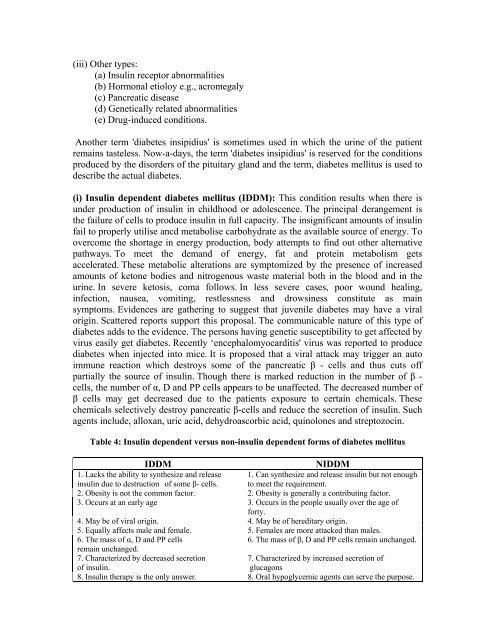MEDICINAL CHEMISTRY
MEDICINAL CHEMISTRY
MEDICINAL CHEMISTRY
You also want an ePaper? Increase the reach of your titles
YUMPU automatically turns print PDFs into web optimized ePapers that Google loves.
(iii) Other types:<br />
(a) Insulin receptor abnormalities<br />
(b) Hormonal etioloy e.g., acromegaly<br />
(c) Pancreatic disease<br />
(d) Genetically related abnormalities<br />
(e) Drug-induced conditions.<br />
Another term 'diabetes insipidius' is sometimes used in which the urine of the patient<br />
remains tasteless. Now-a-days, the term 'diabetes insipidius' is reserved for the conditions<br />
produced by the disorders of the pituitary gland and the term, diabetes mellitus is used to<br />
describe the actual diabetes.<br />
(i) Insulin dependent diabetes mellitus (IDDM): This condition results when there is<br />
under production of insulin in childhood or adolescence. The principal derangement is<br />
the failure of cells to produce insulin in full capacity. The insignificant amounts of insulin<br />
fail to properly utilise ancd metabolise carbohydrate as the available source of energy. To<br />
overcome the shortage in energy production, body attempts to find out other alternative<br />
pathways. To meet the demand of energy, fat and protein metabolism gets<br />
accelerated. These metabolic alterations are symptomized by the presence of increased<br />
amounts of ketone bodies and nitrogenous waste material both in the blood and in the<br />
urine. In severe ketosis, coma follows. In less severe cases, poor wound healing,<br />
infection, nausea, vomiting, restlessness and drowsiness constitute as main<br />
symptoms. Evidences are gathering to suggest that juvenile diabetes may have a viral<br />
origin. Scattered reports support this proposal. The communicable nature of this type of<br />
diabetes adds to the evidence. The persons having genetic susceptibility to get affected by<br />
virus easily get diabetes. Recently ‘encephalomyocarditis' virus was reported to produce<br />
diabetes when injected into mice. It is proposed that a viral attack may trigger an auto<br />
immune reaction which destroys some of the pancreatic β - cells and thus cuts off<br />
partially the source of insulin. Though there is marked reduction in the number of β -<br />
cells, the number of α, D and PP cells appears to be unaffected. The decreased number of<br />
β cells may get decreased due to the patients exposure to certain chemicals. These<br />
chemicals selectively destroy pancreatic β-cells and reduce the secretion of insulin. Such<br />
agents include, alloxan, uric acid, dehydroascorbic acid, quinolones and streptozocin.<br />
Table 4: Insulin dependent versus non-insulin dependent forms of diabetes mellitus<br />
IDDM NIDDM<br />
1. Lacks the ability to synthesize and release 1. Can synthesize and release insulin but not enough<br />
insulin due to destruction of some β- cells. to meet the requirement.<br />
2. Obesity is not the common factor. 2. Obesity is generally a contributing factor.<br />
3. Occurs at an early age 3. Occurs in the people usually over the age of<br />
forty.<br />
4. May be of viral origin. 4. May be of hereditary origin.<br />
5. Equally affects male and female. 5. Females are more attacked than males.<br />
6. The mass of α, D and PP cells<br />
remain unchanged.<br />
6. The mass of β, D and PP cells remain unchanged.<br />
7. Characterized by decreased secretion<br />
7. Characterized by increased secretion of<br />
of insulin.<br />
glucagons<br />
8. Insulin therapy is the only answer. 8. Oral hypoglycemic agents can serve the purpose.

















